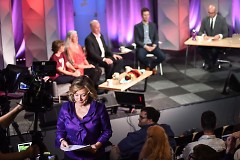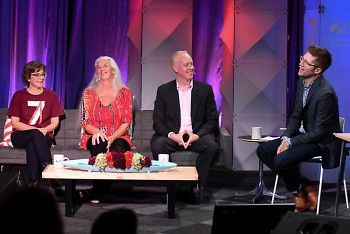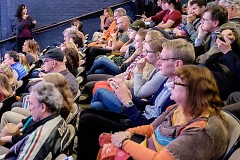Video courtesy of WOOD TV8
What elements make a participatory work…work? What makes magic? And why on earth was that death row prisoner given spaghetti instead of spaghettios?
These were the key focal points of last night’s Critical Discourse: Why These Finalists? (Part 2) panel discussion at ArtPrize’s HUB on Sheldon, which focused on a selection of both public and juried finalists in the 3D and Time-Based categories. The three panelists for this discussion were Sarah Schultz, an independent curator whose work includes curation at the Walker Art Center in Minneapolis; Edward Winkleman, writer and owner of the Winkleman Gallery in NYC; and perhaps most notably: Crimson Rose, co-founder of Burning Man.
These veterans to interactive art examined finalists chosen by both the public and ArtPrize’s jurors in a discussion led by ArtPrize’s Todd Herring, Director of Creative and Communications, and Kevin Buist, Director of Exhibitions. Entries chosen for the discussion were often juxtaposed in pairs of juried and public voted entries focused on related subject matters, which led to a revealing examination of just exactly what makes works in these categories successful - and what makes them fail.
Underlying the night’s discussion was the observation that scale, shininess,and action without meaning are not key ingredients to a successful work. Instead, the common elements which delighted panelists were the relevance of the work’s story, surprising humor, and genuine audience engagement.
“People like magic,” commented Schultz regarding the public voted finalist “MAYA 7624” at Fed Galleries at KCAD. “And this piece has magic.” Each of the panelists agreed that they liked the way this 3D wire sculpture interacted with viewers from different angles, but the irrelevance of the subject matter was distracting.
“The fact that it was a portrait of a woman was beside the point,” observed Winkleman, noting that thought beautiful in material and execution, the subject of the work had little relevance to its medium or story.
Similarly, Schultz observed that the publicly selected “Seasons” at the Amway Grand Plaza Hotel was “shiny, and people love shiny things,” an observation which brought hearty applause from the audience. While, again, perhaps beautiful in material and execution, panelists agreed this entry was missing something. Rose observed that the work “didn’t go far enough,” and that the audience’s inability to explore and interact with the work was distracting. “Seasons” was held in comparison to the UICA’s “Relic”, a fabric work depicting meat carcasses and wings made from the artist’s own “cannibalized wardrobe.” All three panelists felt engaged by the realistic work, which felt “inventive and surprising,” according to Winkleman.
Another favorite of the panelists was “The Last Supper” at KCAD, a work depicting the last meal requests of death row inmates painted in cobalt blue on salvaged ceramic plates. This work resonated deeply with each of the panelists, surprising them with its juxtaposition of tragedy and humor.
“I’m a big believer that you don’t see the truth unless you see the funny side as well…and that’s what jumped out at me…this is the last meal of someone’s life, but there’s a tragic comedy to it,” said Winkleman.
Schultz’s favorite plate in “The Last Supper” included a plea from the inmate: “Please tell the media that I asked for spaghettios, and only got spaghetti” - a humorous and equally tragic sentiment which both Schultz and Rose found extremely powerful.
Size doesn’t equal success was another point of agreement between the panelists during the examination of the large-scale, publicly selected 3D sculpture “Rolling Down” at the Amway Grand. The panelists were each nonplussed by the sensationalism of the work’s execution, and the heavy-handedness of its subject, which revolved around a quote about justice by Dr. Martin Luther King Jr., though none of the panelists saw the connection.
“Sometimes something large doesn’t make it better,” commented Rose - a notable comment coming from a person known as “the woman who brought fire dancing to burning man.”
“WTF, WTF!?” posed Schultz, while Winkleman kindly observed that “this looks like a repurposed prop from an Indiana Jones movie.”
Panelists also gave a surprising critique of the juried favorite “Anishinaabensag Biimskowebshkigewag (Native Kids Ride Bikes)” at the Grand Rapids Art Museum (GRAM), a work made collaboratively with urban Native American youth. While panelists found the subject matter fascinating and the execution beautiful, general consensus was that it missed a kinesthetic element.
“There was no real indication of the children’s hands…I wanted to see some sign of the kids,” commented Winkleman, echoed by Rose’s observation that she “wanted to see more.” Schultz observed that it may simply have been a curatorial problem, and the space didn’t allow viewers to interact with the work as well as they should have.
The discussion turned towards the nature of successful participation as panelists compared the publicly selected “BREAKTHROUGH” to “Whisper”, the only ArtPrize Seven entry to win both juried and public votes. Both works call for the participation of audiences to smash plates; “BREAKTHROUGH” combined a static mural with a “breaking studio,” in which audiences could write a message on a plate then smash it - but only at certain times. The resulting smashed plates were not incorporated in the work’s static mural. “Whisper,” on the other hand, engages audiences by responding to whispers in a microphone with tremors across a long table elegantly set for dinner. Plates and cutlery fall and smash as audiences prompt the work to life with their hushed voices.
“I didn’t have a breakthrough with BREAKTHROUGH!” commented Schultz, observing that the disconnect between the audience’s participation and the visual work itself detracted from the work’s message.
“People couldn’t consistently participate,” she said, which the panelists agreed ultimately made “BREAKTHROUGH” unsuccessful as a participatory work. “Whisper,” on the other hand, culled unanimous approval.
“For me, this piece hits every point,” said Schultz. "It’s also fun to watch other people do it." To Winkleman, the work “illustrated the potential of ArtPrize,” and was “conceptually solid.”
“It was delightful, because the audience could actually participate,” said Rose.
The panelists also fangirled over “Higher Ground” at SiTE:LAB’s Rumsey Street Project, a time-based installation featuring a pink painted house in which up to nine women in white dresses and red shoes continually swing in and out of the house’s windows.
“It’s absolutely delightful,” purred Rose, “the colors, not being able to see all of the women...”
“To me, it was like meeting someone and falling in love,” said Schultz, who hadn’t known the work was created by the well-known artist Kate Gilmore when she first viewed it. Winkleman lamented that the piece made him want to wear a white dress and participate on the swings - but he was nonetheless enamored with the movement of the women and the overall sensation of the work. Panelists agreed that audiences might not be able to participate directly-though it was noted that people can sign up to participate- but the work feels deeply engaging nonetheless.
The tone of the conversation shifted sharply as Kevin Buist prepared the panelists to discuss the wildly popular public voted time-based entry “Hometown Hero.” This “touchable art” depicts a giant American flag and an American soldier, and invites audiences to “commemorate the life of their hero” by doodling or writing a name of their hero on the work.
In sharp contrast to the discussion around any of the other works, Buist strongly qualified the introduction of the heavily patriotic “Hometown Hero” before diving in, noting how important it was for audiences to understand that “we’re critiquing artwork tonight…we’re not critiquing the story, or the sacrifices made.” In line with Buist’s qualifier were a barrage of visibly pulled punches from the panelists.
“We all really like how participatory the work is,” enforced Winkleman, immediately followed by the panelist’s caged observations that the audience’s participation in the work had little relevance to the specific story being told of the soldier in the artist’s description which accompanies the work.
“It went flat,” Rose finally admitted.
“It was the notion of the hometown hero - your everyday hero - against the stark patriotism that clashed…it wasn’t resolved,” observed Schultz, reluctantly concluding, “as a participatory work…it didn’t work.”
The nature of audience participation was brought to the forefront over and over again as panelists examined time-based entries, creating a common theme: for participatory works to succeed, audiences must have some direct involvement in creating the work itself, and the story of the work must be relevant to that participation.
The Rapidian, a program of the 501(c)3 nonprofit Community Media Center, relies on the community’s support to help cover the cost of training reporters and publishing content.
We need your help.
If each of our readers and content creators who values this community platform help support its creation and maintenance, The Rapidian can continue to educate and facilitate a conversation around issues for years to come.
Please support The Rapidian and make a contribution today.


